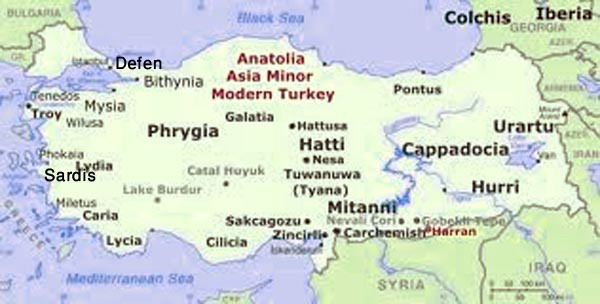British Hebrews and the West (3 March, 2014, 1 Adar-2, 5774)
Continued from Hesperides part 1
Contents:
8. The Hesperides and Sepharad
9. Leviathan
10. Cimmerians in the West
11. The Welsh
12. Conclusion
====
====

====
====
8. The Hesperides and Sepharad
The third Hesperidi maiden was Hespere from which we receive the name Hesperides. The namer of Hespere and of the Heseperides may be derived from the word Sepharad. This name had been applied to Sardis in Lydia but was later applied to Spain.
Sepharad in Jewish Tradition is the name for Spain. It is mentioned in the Biblical Book of Obadiah in a passage concerning the future whereabouts of Exiles from the Ten Tribes and from Judah.
Literal Translation.
Obadiah 1:
20 This first exiles of the Children of Israel who are [extend from] the Canaaanites to Zarephath;
and the exiles of Jerusalem who are in Sepharad shall possess the towns of the south [Negeb].
Translation in the Light of Commentaries:
[Obadiah 1:20]
AND THIS FIRST EXILE OF THE TEN TRIBES OF ISRAEL [Rashi] WHO DWELL FROM GERMANY [=CANAANITES, Iben Ezra] AND HOLLAND [Jewish sources quoted by Calvin], EVEN UNTO FRANCE [=ZAREPHATH, Rashi, Iben Ezra, Radak, Abarbanel, Daat Sofrim] AND ENGLAND [= ZAREPHATH, Abarbanel] AND THE CAPTIVITY OF THE JEWS OF JERUSALEM IN SPAIN [=SEPHARAD, Targum Yehonatan] SHALL POSSESS THE CITIES OF THE SOUTH.
See:
THE LOST TEN TRIBES AND TSEREFAT
http://www.britam.org/Proof/geo/geoTserefat.html
Brit-Am Commentary to the Book of Obadiah
http://britam.org/obadiah.html
====
====
9. Leviathan
The Hesperides were usually said to live in the west beyond the sunset, but the Greek poet and grammarian Apollonius of Rhodes (200s BCE) placed them in North Africa. Apollodorus (100s BCE) located them among the Hyperboreans meaning Hebrews of the North. The golden apples were also guarded by the dragon Ladon.
The dragon Ladon is a form of Leviathan often associated with Britain.
Leviathan is the title of Thomas Hobbes' 1651 work on the social contract and the origins of creation of an ideal state, and his proper name for the Commonwealth.
====
====
10. Cimmerians in the West
The Lost Ten Tribes merged with the people of Gomer otherwise known as the Cimmerians. They moved to the West. Welsh tradition links their ancestors to Gomer and the Cimmerians. The Welsh Language derives in part from Hebrew, so does Irish.
Duration: 13.19 minutes. To Continue Reading the Article Please Scroll Down!
The Ten Tribes were exiled to different portions of the Assyrian Empire. They became associated with a federation of other peoples associated with Gomer son of Japhet.
This is reflected in the first chapter of the Book of Hosea where the Ten Tribes in their places of exile are described as children of a loose woman named Gomer. The peoples of Gomer are otherwise known as the Cimmerians and Scythians. They first appeared in the Middle East but shortly afterwards appear in the West. This was a result of the transference of the Ten Tribes to western areas.
Homer (possibly written in the 400s BCE) placed the Cimmerians (Odyssey, Book 11, 14) as living in the Atlantic Oceanus, in a land of fog and darkness, at the edge of the world and the entrance of Hades. This has been understood as referring to Britain.
Hecateus of Abdera (ca. 350-300 BCE) mentioned a Cimmerian city amongst the Hyperboreans in the north of Europe.
Pseudo-Orpheus (later 300s BCE) placed the Cimmerians in the Atlantic Ocean or along the North Sea coast of Europe to the west of the Alps. He says, the Cimmerians, were without the splendid light of the sun and always in darkness. This also indicates the far north of Europe in winter-time. He also speaks of there being, somewhere in the same direction.
"the most just tribe of men, for whom transport by a single ship alone suffices after death: for their souls cross over the Acheron from the city by ship immediately. Near this are cities, unconquered gates to Hades, and the land of phantoms. "
This description corresponds with beliefs held by the Romans (as recorded by Caesar) concerning the inhabitants of Britain. It also fits notions held by the Jews in 2nd Temple Times about the Lost Ten Tribes.
The Cimmerians are identifiable with Gomer.
====
====
11. The Welsh
The Welsh call themselves Gomri and their language Gymraeg. This may be linked to Gomer even though linguists relate the Welsh name to a root connoting companion. The two explanations however do not necessarily contradict each other:
Often existing names are reinterpreted in the light of colloquial understanding which does not reflect their origin.
The Welsh traced one of their main streams to Hu Gadarn who had come from Dephrobane opposite Byzantium to Defenia (Southwest Britain, cf. the name Devon in England). So too, Dephrobane opposite Byzantium is to be identified with a port to the northwest of Phrygia that was named Defen.
Other sources trace the Ancient British to Troy which is in the same neighborhood.
====
====
12. Conclusion
The Lost Ten Tribes were exiled in conventional dating in the period ca. 730-720 BCE. This was the time when Phrygia had began to utilize the tin resources of Britain following which the Cimmerians conquered them. The Cimmerians then appear in the same area. The Cimmerians are identifiable as Gomer and with the Ten Tribes. So too legends and names pertaining to the Hesperides and other entities indicate a movement from this area to the west.
This is consistent with our conclusions that the Ten Tribes did indeed move to western areas.
